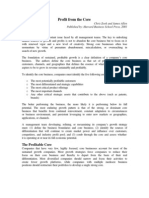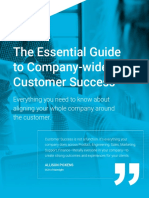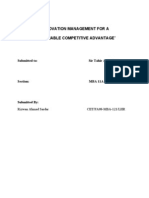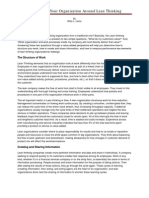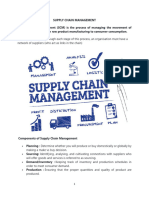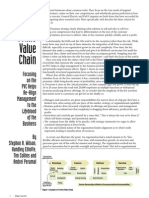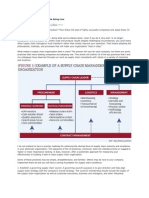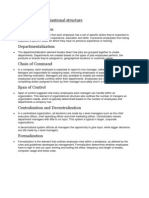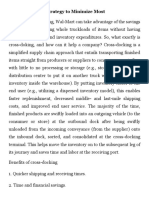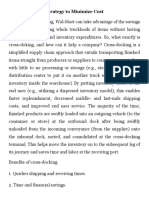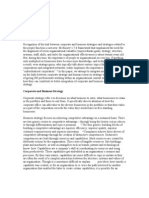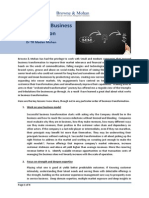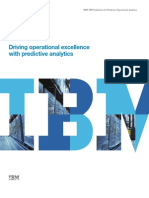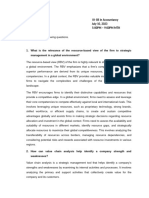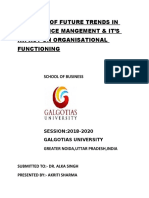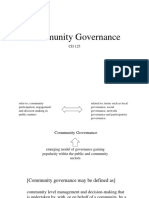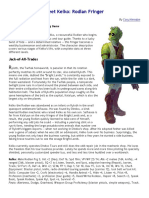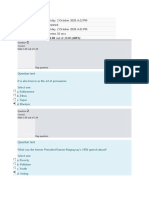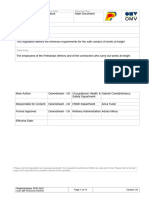Lean Organisation Structure - Organisation Development - Infinity People
Lean Organisation Structure - Organisation Development - Infinity People
Uploaded by
Infinity PeopleCopyright:
Available Formats
Lean Organisation Structure - Organisation Development - Infinity People
Lean Organisation Structure - Organisation Development - Infinity People
Uploaded by
Infinity PeopleCopyright
Available Formats
Share this document
Did you find this document useful?
Is this content inappropriate?
Copyright:
Available Formats
Lean Organisation Structure - Organisation Development - Infinity People
Lean Organisation Structure - Organisation Development - Infinity People
Uploaded by
Infinity PeopleCopyright:
Available Formats
Lean Organisation Structure – Need of the
hour
Turning over a new leaf whilst taking stock of the traditional ways which you
have been doing your damndest in, can prove to be dodgy sometimes. Aligning
with the very same context, organisations tend to pay heed to the recently
perceived lean organisation structure whilst concurrently embracing the
illustrative aspects of the traditional organisational structure.
The frantic rush following the upsurge of the novel coronavirus had enterprises at
their wits’ end for investing heavily into the tangible assets was a hard row to
hoe. On that account, lean organisation structure becomes the top priority of
all firms, which meets the contemporary demand of creating higher customer
value whilst operating with fewer or limited resources.
Flouting excessive utilization of resources and zeroing in on
assessing and establishing customer value
Multiple sets of functional departments are actively being given the go-by
for knocking out the extraneous waste in the manufacturing sectors.
Allegedly, investments are falling and, private sectors do not seem to show
any appetite for it. Nonetheless, Organisation development during such
critical and challenging Covid times rushes on a flexible structure, which is
responsive to the ever-changing customer needs howbeit not digging a
hole in the pockets of the PLCs.
Pooling the available resources and building a sturdy and cohesive
relationship within the manpower arrangement
For a business to jack up the market and survive the ongoing situations, it
unarguably requires its constituting members to have a collaborative
approach and keep an eye peeled for the organisational proceedings.
Infinity People encourages the multi-faceted processes involved in team
cohesion whilst developing a sense of perceived unity within its
entrepreneurial ecosystem of white-collar workers.
Empowering employees to get to grips with the root causes of
complex problems
One of the most fundamental aspects of the lean organisational structure
involves hunkering down for a time being to have a crack at the main
grounds of the complex problems, of the organisational setup processes.
Certainly, near future goals of any enterprise will stand in the need of
pioneering solutions at each step. Additionally, proactive and dynamic
procedures within the firm carry huge weight in blowing away the cobwebs
of the team involved.
Placing analysis of customer feedback at the discretion of the
moderators within the firm
Figures estimate that around 96% consumers hold the customer service
and feedback analysis in high regard when determining their choice of
loyalty to a particular brand. Lack of great customer responsiveness can
make an enterprise put its value acquisition from returning customers on
stake. Let us be honest – the more responsive and reachable you are to
your customers, the more credibility you are bound to procure.
Implementing material and information-flow mapping method for
analysing the organisational design
Material and information-flow mapping or more commonly, value stream
mapping is an essential lean tool displaying an array of central steps
involved in individual processes while, simultaneously evaluating the time
taken at each stage. As can be seen, organisations can utilize the VSM tool
for processing uptimes and downtimes, singling out and cutting down
waste, intensifying the value stream’s efficiency and improving the overall
process management. We cannot stress more on its inevitable need in the
post-Covid times!
Situations change; so should the working procedures of the enterprises
that aspire to mount up their market value in the coming times.
Undoubtedly, the lean structure will run a major league for
organisations to expand their resources quite frequently. However, we
cannot deny the fact that lean culture can only take a successful turn if
employees’ involvement in value improvement are cherished and
admired.
You might also like
- Profit From The CoreDocument8 pagesProfit From The CoreArnab HazraNo ratings yet
- # (Article) Integrated Business Planning - A Roadmap To Linking S&OP and CPFR (2011)Document10 pages# (Article) Integrated Business Planning - A Roadmap To Linking S&OP and CPFR (2011)AbusamraMousaNo ratings yet
- A Practical Approach To Post-Merger IntegrationDocument8 pagesA Practical Approach To Post-Merger Integrationme2ubond100% (1)
- PWC Internal Change CapabilityDocument14 pagesPWC Internal Change CapabilityRamona PaulaNo ratings yet
- Gainsight - The Essential Guide To Company-Wide Customer SuccessDocument21 pagesGainsight - The Essential Guide To Company-Wide Customer SuccessManlio SegaboniNo ratings yet
- Enterprise Agility PWCDocument8 pagesEnterprise Agility PWCvenchilexNo ratings yet
- Surf Excel ProjectDocument12 pagesSurf Excel ProjectMuhammad Asghar100% (1)
- Capabity Framework of OrganizationsDocument9 pagesCapabity Framework of Organizationsimkazi303No ratings yet
- Lean Redesign Your Organization 030911Document3 pagesLean Redesign Your Organization 030911sribalaji22No ratings yet
- The Quest of Customer Focus.Document5 pagesThe Quest of Customer Focus.Pankaj Kumar Bothra100% (1)
- The Organization of The 90sDocument10 pagesThe Organization of The 90ssaketanand2019No ratings yet
- Supply Chain ManagementDocument28 pagesSupply Chain ManagementCrispin MponjiNo ratings yet
- Impedement To LeanDocument30 pagesImpedement To LeanIzumi KōheiNo ratings yet
- Organizing Operations For CompetitionDocument4 pagesOrganizing Operations For CompetitionMarica ShaneNo ratings yet
- Kaizen Blog - Lean: Time Management vs. Cost ManagementDocument7 pagesKaizen Blog - Lean: Time Management vs. Cost ManagementKyaw Min HanNo ratings yet
- Supply Chin TypesDocument19 pagesSupply Chin TypesWAR FIRENo ratings yet
- Discover Your Prime Value Chain Align JournalDocument5 pagesDiscover Your Prime Value Chain Align JournalWilson Perumal & CompanyNo ratings yet
- SM Qa-15Document10 pagesSM Qa-15Shahwaiz Bin Imran BajwaNo ratings yet
- Essentials of HRMDocument13 pagesEssentials of HRMRochak SinglaNo ratings yet
- Estrategia Simple LogisticaDocument11 pagesEstrategia Simple LogisticaCristian Muñoz SanchezNo ratings yet
- 009麦肯锡新员工培训手册Document91 pages009麦肯锡新员工培训手册wangzibin1984No ratings yet
- Supplier Relationship Management: Strategy GuideDocument11 pagesSupplier Relationship Management: Strategy GuideAron Ruben Flores ZarzosaNo ratings yet
- 10 Best Practices Supply ChainDocument5 pages10 Best Practices Supply ChainAseem SangarNo ratings yet
- Title: The Rise of Agile Management: Adapting To Change in The Digital AgeDocument3 pagesTitle: The Rise of Agile Management: Adapting To Change in The Digital Ageresourcessharingrr2No ratings yet
- BAI Business Agility Report 2022Document35 pagesBAI Business Agility Report 2022dfdfgNo ratings yet
- Focusing On ProjectDocument4 pagesFocusing On Projectmbon76No ratings yet
- Supply Chain Management by Sigi OsagieDocument4 pagesSupply Chain Management by Sigi OsagieKristina Noëlle TijanNo ratings yet
- Sample Thesis On Working Capital ManagementDocument8 pagesSample Thesis On Working Capital ManagementWhoCanWriteMyPaperForMeSingapore100% (2)
- Fundamentals of Manufacturing ExcellenceDocument8 pagesFundamentals of Manufacturing ExcellenceFadi Zaid Alkilani0% (1)
- Supply Chain ManagementDocument2 pagesSupply Chain ManagementCharice Anne VillamarinNo ratings yet
- Elements of Organisational Structure Work SpecializationDocument6 pagesElements of Organisational Structure Work SpecializationPrakhar GuptaNo ratings yet
- Introduction To OrganizationsDocument4 pagesIntroduction To OrganizationsPearl ShellNo ratings yet
- Cross-Doking As Strategy To Minimize MostDocument4 pagesCross-Doking As Strategy To Minimize MostMichael YohannesNo ratings yet
- Cross-Doking As Strategy To Minimize CostDocument4 pagesCross-Doking As Strategy To Minimize CostMichael YohannesNo ratings yet
- 10 Best PracticesDocument4 pages10 Best PracticesMihaela BotezanNo ratings yet
- Linking Corporate Strategy and HR StrategyDocument7 pagesLinking Corporate Strategy and HR Strategybiloo123No ratings yet
- Building World-Class Finance and Performance Management CapabilitiesDocument8 pagesBuilding World-Class Finance and Performance Management CapabilitiesChung Chee YuenNo ratings yet
- Intellectual CapitalcDocument4 pagesIntellectual CapitalcshuvoertizaNo ratings yet
- Final Exam (Take Home) Spring - 2020 Subject: Submission Day: Saturday Instructor: Submission Date: May 30, 2020 Program: Max. Marks: 40Document5 pagesFinal Exam (Take Home) Spring - 2020 Subject: Submission Day: Saturday Instructor: Submission Date: May 30, 2020 Program: Max. Marks: 40Sid SshrNo ratings yet
- This Report Is Brought in Co-Operation With Cattan Service GroupDocument18 pagesThis Report Is Brought in Co-Operation With Cattan Service GrouptalehzarbaliNo ratings yet
- Factor Affecting The Growth of Supply Chain Management in Indian Apparel IndustryDocument23 pagesFactor Affecting The Growth of Supply Chain Management in Indian Apparel IndustryPriti RoyNo ratings yet
- 13 Lessons For SME Business TransformationDocument4 pages13 Lessons For SME Business TransformationBrowne and MohanNo ratings yet
- Assignment1 - 1 20Document20 pagesAssignment1 - 1 20Andy BangsNo ratings yet
- Organizational-Theory-Structure-And-Design December 2021Document6 pagesOrganizational-Theory-Structure-And-Design December 2021Aman SharmaNo ratings yet
- Operations StrategyDocument32 pagesOperations StrategyLieutenantNo ratings yet
- Scaling AgileV2Document6 pagesScaling AgileV2Hakan DanisikNo ratings yet
- UlgaDocument4 pagesUlgabonar napitupuluNo ratings yet
- Buy-Side Business Attribution - TABB VersionDocument11 pagesBuy-Side Business Attribution - TABB VersiontabbforumNo ratings yet
- SMR 3Document3 pagesSMR 3snk1974No ratings yet
- Organizing As Management Function in Business OrganizationDocument8 pagesOrganizing As Management Function in Business Organizationshivprasadp108No ratings yet
- Deloitte CaseDocument4 pagesDeloitte CaseTingyu ChenNo ratings yet
- BCG Exercising For Excellence July 2015 - tcm9 64577Document22 pagesBCG Exercising For Excellence July 2015 - tcm9 64577ErikNo ratings yet
- Driving Op ExcellenceDocument16 pagesDriving Op ExcellenceGabriel Rojas GuerreroNo ratings yet
- Activity No. 1 Midterm Strategic ManagementDocument5 pagesActivity No. 1 Midterm Strategic ManagementSarah CandilasaNo ratings yet
- Impact of perfo-WPS OfficeDocument12 pagesImpact of perfo-WPS OfficeManoranjan SharmaNo ratings yet
- Dissertation DraftDocument4 pagesDissertation Draftnicoleho1411No ratings yet
- From Startup to Scale - A Founder’s Guide to Rapid Business ExpansionFrom EverandFrom Startup to Scale - A Founder’s Guide to Rapid Business ExpansionNo ratings yet
- Strategic Consulting: Tools and methods for successful strategy missionsFrom EverandStrategic Consulting: Tools and methods for successful strategy missionsNo ratings yet
- EVALUATING THE ROLE OF CORE COMPETENCIES IN IMPROVING PERFORMANCE OF MANUFACTURING INDUSTRIESFrom EverandEVALUATING THE ROLE OF CORE COMPETENCIES IN IMPROVING PERFORMANCE OF MANUFACTURING INDUSTRIESNo ratings yet
- Business Process Mapping: How to improve customer experience and increase profitability in a post-COVID worldFrom EverandBusiness Process Mapping: How to improve customer experience and increase profitability in a post-COVID worldNo ratings yet
- How Outsourcing Is Changing and Evolving As A Concept - Outsourcing Firm - Infinity PeopleDocument2 pagesHow Outsourcing Is Changing and Evolving As A Concept - Outsourcing Firm - Infinity PeopleInfinity PeopleNo ratings yet
- Building Company Culture - Culture Building in Organisation - Infinity PeopleDocument2 pagesBuilding Company Culture - Culture Building in Organisation - Infinity PeopleInfinity PeopleNo ratings yet
- HR Consultant - Infinity PeopleDocument2 pagesHR Consultant - Infinity PeopleInfinity PeopleNo ratings yet
- Payroll Management Services - Infinity PeopleDocument2 pagesPayroll Management Services - Infinity PeopleInfinity PeopleNo ratings yet
- DLL - Science 4 - Q2 - W10Document5 pagesDLL - Science 4 - Q2 - W10Niña HipolitoNo ratings yet
- M0gle - Water ADocument47 pagesM0gle - Water AAddis Girma100% (1)
- PROKON Structural Analysis and DesignDocument9 pagesPROKON Structural Analysis and Designmanhal alnoaimy100% (1)
- Community GovernanceDocument17 pagesCommunity GovernanceJustin TayabanNo ratings yet
- Character - KelkoDocument3 pagesCharacter - KelkoSW-FanNo ratings yet
- Reading&Writing 144 Copies Wave 4 Set BDocument5 pagesReading&Writing 144 Copies Wave 4 Set BHenna Jane Bael0% (1)
- Paragraph WritingDocument4 pagesParagraph WritingabhieNo ratings yet
- Started On Friday, 2 October 2020, 6:22 PM State Finished Completed On Friday, 2 October 2020, 6:31 PM Time Taken 9 Mins 16 Secs Grade 20.00 Out of 20.00 (100%)Document6 pagesStarted On Friday, 2 October 2020, 6:22 PM State Finished Completed On Friday, 2 October 2020, 6:31 PM Time Taken 9 Mins 16 Secs Grade 20.00 Out of 20.00 (100%)Princess Diane BallesterosNo ratings yet
- Thinking Like A GeniusDocument2 pagesThinking Like A Genius张文峰No ratings yet
- Saving Lives and Saving MoneyDocument11 pagesSaving Lives and Saving MoneyDaniel MeloNo ratings yet
- 1 PBDocument9 pages1 PBADELIN KALENGKONGANNo ratings yet
- Reading Test: in You Variety of Will LastDocument3 pagesReading Test: in You Variety of Will LastTùng ThắngNo ratings yet
- Lenses and Mirrors PDFDocument13 pagesLenses and Mirrors PDFKristiane Reyes De VillaNo ratings yet
- Ipc Notes PDFDocument19 pagesIpc Notes PDFdhruvNo ratings yet
- Antioxidant Activitiy of Bitter Leaves (Vernonia Amygdalina) Extract Coated With The Nanochitosan Derived From Parrot Fish (Scarus SP) ScalesDocument8 pagesAntioxidant Activitiy of Bitter Leaves (Vernonia Amygdalina) Extract Coated With The Nanochitosan Derived From Parrot Fish (Scarus SP) Scalesgtsa2220393No ratings yet
- Class 11 Biology NCERT Textbook Chapter 1 The Living WorldDocument20 pagesClass 11 Biology NCERT Textbook Chapter 1 The Living WorldROHAN SHARMANo ratings yet
- New TIP Course 1 DepEd TeacherDocument147 pagesNew TIP Course 1 DepEd TeachershiesermNo ratings yet
- GizawDocument10 pagesGizawEsayase AsnakeNo ratings yet
- US46068483Document6 pagesUS46068483hanzNo ratings yet
- Dokumen - Tips - Astm A535 9 Percent NickelDocument5 pagesDokumen - Tips - Astm A535 9 Percent NickelJeovanne CabralNo ratings yet
- Research OrganizationalbehaviorDocument8 pagesResearch Organizationalbehaviorram.aws19No ratings yet
- Conceptualizational Research Gap - AssignmentDocument26 pagesConceptualizational Research Gap - Assignment34 NIVEDITA SNo ratings yet
- Understanding The PCB Drilling Process For Different Hole Types and Locations - TempoDocument10 pagesUnderstanding The PCB Drilling Process For Different Hole Types and Locations - TempoAldrin AtolleNo ratings yet
- DGS-MU-012-R1 Requirements For Manufacturing Data Report For Non-Pressure Vessel EquipmentDocument10 pagesDGS-MU-012-R1 Requirements For Manufacturing Data Report For Non-Pressure Vessel EquipmentHalim KazdarNo ratings yet
- Pioneer Vsx-lx50 91txh 9120txh-kDocument266 pagesPioneer Vsx-lx50 91txh 9120txh-kmksmrmshknNo ratings yet
- Barriers of CommunicationDocument19 pagesBarriers of Communicationanandkaushik475No ratings yet
- Hypo Chlorite Test: FormulaDocument1 pageHypo Chlorite Test: Formulafitashah2634No ratings yet
- SPR-0421-Working at Height - EnGDocument15 pagesSPR-0421-Working at Height - EnGTzushk47100% (1)
- Rekha Academy Setup Details (Advance)Document16 pagesRekha Academy Setup Details (Advance)UZARA KHANNo ratings yet
- Inglish CV DBV PDFDocument3 pagesInglish CV DBV PDFDelfino Bernardo ViegasNo ratings yet
